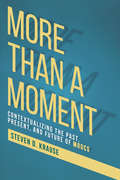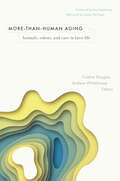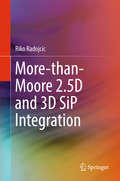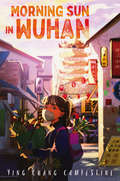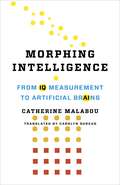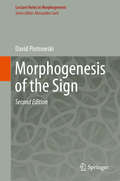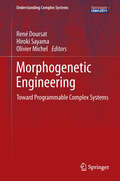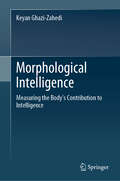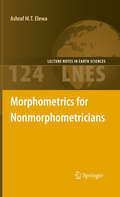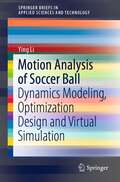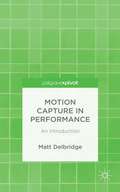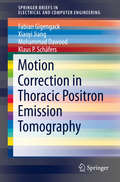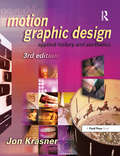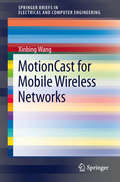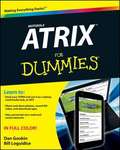- Table View
- List View
More than a Moment: Contextualizing the Past, Present, and Future
by Steven D. KrauseAs recently as 2012, massive open online courses (MOOCs) looked poised to revolutionize higher education, but in just a few years their flaws and problems have made them into a less relevant model. In More than a Moment, Steven D. Krause explores MOOCs and their continuing impact on distance learning in higher education, putting them in the context of technical innovations that have come before and those that will be part of the educational future. Krause writes about his own experiences as a participant in several MOOCs and the experiences of faculty who developed and taught MOOCs. Contrary to many early claims from educational entrepreneurs, they were never entirely “new,” and MOOCs and their aftermath are still at the heart of the tensions between nonprofit universities and for-profit entities, particularly online program management firms, in delivering distance education. While MOOCs are no longer a threat to education in the United States, they are part of the ongoing corporatization of education and remain part of conversations about experienced-based credit, corporate training, and open education. Presenting historical, student, teacher, and administrative perspectives, More than a Moment is a well-rounded treatment that will be of interest to academics and entrepreneurs interested in distance education, online pedagogy, online program management, and public-private partnerships in higher education.
More-than-Human Aging: Animals, Robots, and Care in Later Life (Global Perspectives on Aging)
by Andrew Whitehouse Cristina DouglasWhat does later life look like when it is lived in the companionship of other species? Similarly, how do other species age (or not) with humans, and what sort of (a)symmetries, if any, are brought to light around how we understand and think about aging? So far, aging has been investigated in the social sciences in purely human terms. This is the first collection of original work that considers aging as taking place in relation to other species. This volume aims to start a conversation about aging by taking its more-than-human participants seriously—that is, not only as a support for or context of human aging but also, more symmetrically, as agents and subjects in the process of aging. The contributors draw upon richly descriptive ethnographic accounts, including moments of connection between seniors and dogs in a long-term care facility, human care for aging laboratory animals, and robotic companionship in later life. The ethnographies in this volume not only enrich our understanding of more-than-human companionship during the human aging process but also challenge and urge us to rethink what it means to live later in life in ecologically entangled social and moral worlds.
More-than-Moore 2.5D and 3D SiP Integration
by Riko RadojcicThis book presents a realistic and a holistic review of the microelectronic and semiconductor technology options in the post Moore's Law regime. Technical tradeoffs, from architecture down to manufacturing processes, associated with the 2. 5D and 3D integration technologies, as well as the business and product management considerations encountered when faced by disruptive technology options, are presented. Coverage includes a discussion of Integrated Device Manufacturer (IDM) vs Fabless, vs Foundry, and Outsourced Assembly and Test (OSAT) barriers to implementation of disruptive technology options. This book is a must-read for any IC product team that is considering getting off the Moore's Law track, and leveraging some of the More-than-Moore technology options for their next microelectronic product.
Morning Sun in Wuhan
by Ying CompestineWhat was the pandemic of the century like at the start? This swift, gripping novel captures not only the uncertainty and panic when COVID first emerged in Wuhan, but also how a community banded together. Weaving in the tastes and sounds of the historic city, Wuhan&’s comforting and distinctive cuisine comes to life as the reader follows 13-year-old Mei who, through her love for cooking, makes a difference in her community. Written by an award-winning author originally from Wuhan. Grieving the death of her mother and an outcast at school, thirteen-year-old Mei finds solace in cooking and computer games. When her friend&’s grandmother falls ill, Mei seeks out her father, a doctor, for help, and discovers the hospital is overcrowded. As the virus spreads, Mei finds herself alone in a locked-down city trying to find a way to help. Author Ying Chang Compestine draws on her own experiences growing up in Wuhan to illustrate that the darkest times can bring out the best in people, friendship can give one courage in frightening times, and most importantly, young people can make an impact on the world. Readers can follow Mei&’s tantalizing recipes and cook them at home.
Morphing Intelligence: From IQ Measurement to Artificial Brains (The Wellek Library Lectures)
by Catherine MalabouWhat is intelligence? The concept crosses and blurs the boundaries between natural and artificial, bridging the human brain and the cybernetic world of AI. In this book, the acclaimed philosopher Catherine Malabou ventures a new approach that emphasizes the intertwined, networked relationships among the biological, the technological, and the symbolic.Malabou traces the modern metamorphoses of intelligence, seeking to understand how neurobiological and neurotechnological advances have transformed our view. She considers three crucial developments: the notion of intelligence as an empirical, genetically based quality measurable by standardized tests; the shift to the epigenetic paradigm, with its emphasis on neural plasticity; and the dawn of artificial intelligence, with its potential to simulate, replicate, and ultimately surpass the workings of the brain. Malabou concludes that a dialogue between human and cybernetic intelligence offers the best if not the only means to build a democratic future. A strikingly original exploration of our changing notions of intelligence and the human and their far-reaching philosophical and political implications, Morphing Intelligence is an essential analysis of the porous border between symbolic and biological life at a time when once-clear distinctions between mind and machine have become uncertain.
Morphogenesis of the Sign: From Morphodynamics To Neurosciences (Lecture Notes in Morphogenesis)
by David PiotrowskiThis book develops a morphodynamical approach to linguistic and sign structures as an integrated response to multilevel and interrelated problems in semiolinguistic research. More broadly, the content is linked to the realities of living speech through a connection (via the concept of diacriticity) with the Merleau-Pontian phenomenology, and beyond the formal determinations of a semiolinguistic system and its calculus. Such problems are mainly epistemological (concerning the nature and legitimate scope of semiolinguistic knowledge), empirical (concerning the observational device and the data’s composition), and theoretical (regarding the choice of a conceptual and formalized explicative frame). With regard to theory, the book introduces a morphodynamical architecture of linguistic signs and operations as a suitable mathematization of Saussurean theory. The Husserlian phenomenological signification of this formal apparatus is then established, and, from an empirical standpoint, its compatibility with neurobiological experimental results is discussed.
Morphogenetic Engineering
by René Doursat Hiroki Sayama Olivier MichelGenerally, spontaneous pattern formation phenomena are random and repetitive, whereas elaborate devices are the deterministic product of human design. Yet, biological organisms and collective insect constructions are exceptional examples of complex systems that are both self-organized and architectural. This book is the first initiative of its kind toward establishing a new field of research, Morphogenetic Engineering, to explore the modeling and implementation of "self-architecturing" systems. Particular emphasis is placed on the programmability and computational abilities of self-organization, properties that are often underappreciated in complex systems science--while, conversely, the benefits of self-organization are often underappreciated in engineering methodologies. Altogether, the aim of this work is to provide a framework for and examples of a larger class of "self-architecturing" systems, while addressing fundamental questions such as > How do biological organisms carry out morphogenetic tasks so reliably? > Can we extrapolate their self-formation capabilities to engineered systems? > Can physical systems be endowed with information (or informational systems be embedded in physics) so as to create autonomous morphologies and functions? > What are the core principles and best practices for the design and engineering of such morphogenetic systems? The intended audience consists of researchers and graduate students who are working on, starting to work on, or interested in programmable self-organizing systems in a wide range of scientific fields, including computer science, robotics, bioengineering, control engineering, physics, theoretical biology, mathematics, and many others.
Morphological Intelligence: Measuring the Body’s Contribution to Intelligence
by Keyan Ghazi-ZahediIntelligence results from the interaction of the brain, body and environment. The question addressed in this book is, can we measure the contribution of the body and its' interaction with the environment? To answer this, we first present a comprehensive overview of the various ways in which a body reduces the amount of computation that the brain has to perform to solve a task. This chapter will broaden your understanding of how important inconspicuously appearing physical processes and physical properties of the body are with respect to our cognitive abilities. This form of contribution to intelligence is called Morphological Intelligence. The main contribution of this book to the field is a detailed discussion of how Morphological Intelligence can be measured from observations alone. The required mathematical framework is provided so that readers unfamiliar with information theory will be able to understand and apply the measures. Case studies from biomechanics and soft robotics illustrate how the presented quantifications can, for example, be used to measure the contribution of muscle physics to jumping and optimise the shape of a soft robotic hand. To summarise, this monograph presents various examples of how the physical properties of the body and the body’s interaction with the environment contribute to intelligence. Furthermore, it treats theoretical and practical aspects of Morphological Intelligence and demonstrates the value in two case studies.
Morphometrics for Nonmorphometricians
by Ashraf M.T. ElewaMorphometrics is concerned with the study of variations and change in the form (size and shape) of organisms or objects adding a quantitative element to descriptions and thereby facilitating the comparison of different objects and organisms. This volume provides an introduction to morphometrics in a clear and simple way without recourse to complex mathematics and statistics. This introduction is followed by a series of case studies describing the variety of applications of morphometrics from paleontology and evolutionary ecology to archaeological artifacts analysis. This is followed by a presentation of future applications of morphometrics and state of the art software for analyzing and comparing shape.
Morphs, Mallards, and Montages: Computer-Aided Imagination
by Andrew GlassnerThis book is for everyone who's interested in computer graphics and how it can take us on exciting journeys powered by imagination and a love of discovery and invention. Each chapter investigates a unique topic and gives you the tools to continue that exploration on your own. Examine the possibilities of: - Pop-up books and cards - Reconstructing shredded documents - Crop circles - Weaves and Tartans - Morphing images and much more! Browse and enjoy the array of visual ideas or roll up your sleeves and write your own code.
Motion Analysis of Soccer Ball: Dynamics Modeling, Optimization Design and Virtual Simulation (SpringerBriefs in Applied Sciences and Technology)
by Ying LiThe intelligent sports analysis of a soccer ball (also known as football, football ball, or association football ball) requires accurately simulating its motion and finding the best design parameters. Employing classic mechanics, this book establishes a fundamental framework for the soccer ball multi-body dynamics modeling, virtual prototype simulation and optimization design. It presents 3D virtual prototypes to predict the soccer ball trajectory for soccer players and trainers. Five typical case studies have addressed in the kinematics and dynamics simulations of soccer ball projectile motion, free kick, and corner kick in the virtual environment. The research on multi-body dynamics models provides a useful method for engineers and scientists to investigate the spatial kinematics and dynamics performances of various balls, such as soccer ball, gulf ball, American football, etc. The book is significant to guide undergraduate and graduate students from multi-disciplines to study system dynamics and optimization design.
Motion Capture in Performance: An Introduction
by Matt DelbridgeMotion Capture in Performance explores the historical origins, properties and implications of Motion Capture. It introduces a new mode of performance for the commercial film, animation, and console gaming industries - 'Performance Capture', a distinct interdisciplinary discourse in the fields of theatre, animation, performance studies and film.
Motion Control of Biomimetic Swimming Robots (Research on Intelligent Manufacturing)
by Junzhi Yu Min TanThis book reports on the latest advances in the study of motion control in biomimetic swimming robots with high speed and high manoeuvrability. It presents state-of-the-art studies on various swimming robots including robotic fish, dolphins and jellyfish in a unified framework, and discusses the potential benefits of applying biomimetic underwater propulsion to autonomous underwater vehicle design, such as: speed, energy economy, enhanced manoeuvrability, and reduced detectability. Given its scope, the book will be of interest to researchers, engineers and graduate students in robotics and ocean engineering who wish to learn about the core principles, methods, algorithms, and applications of biomimetic underwater robots.
Motion Coordination for VTOL Unmanned Aerial Vehicles: Attitude Synchronisation and Formation Control
by Abdelhamid Tayebi Abdelkader AbdessameudMotion Coordination for VTOL Unmanned Aerial Vehicles develops new control design techniques for the distributed coordination of a team of autonomous unmanned aerial vehicles. In particular, it provides new control design approaches for the attitude synchronization of a formation of rigid body systems. In addition, by integrating new control design techniques with some concepts from nonlinear control theory and multi-agent systems, it presents a new theoretical framework for the formation control of a class of under-actuated aerial vehicles capable of vertical take-off and landing. Several practical problems related to the systems' inputs, states measurements, and restrictions on the interconnection topology between the aerial vehicles in the team are addressed. Worked examples with sufficient details and simulation results are provided to illustrate the applicability and effectiveness of the theoretical results discussed in the book. The material presented is primarily intended for researchers and industrial engineers from robotics, control engineering and aerospace communities. It also serves as a complementary reading for graduate students involved in research related to flying robotics, aerospace, control of under-actuated systems, and nonlinear control theory
Motion Correction in Thoracic Positron Emission Tomography
by Xiaoyi Jiang Fabian Gigengack Mohammad Dawood Klaus P. SchäfersRespiratory and cardiac motion leads to image degradation in Positron Emission Tomography (PET), which impairs quantification. In this book, the authors present approaches to motion estimation and motion correction in thoracic PET. The approaches for motion estimation are based on dual gating and mass-preserving image registration (VAMPIRE) and mass-preserving optical flow (MPOF). With mass-preservation, image intensity modulations caused by highly non-rigid cardiac motion are accounted for. Within the image registration framework different data terms, different variants of regularization and parametric and non-parametric motion models are examined. Within the optical flow framework, different data terms and further non-quadratic penalization are also discussed. The approaches for motion correction particularly focus on pipelines in dual gated PET. A quantitative evaluation of the proposed approaches is performed on software phantom data with accompanied ground-truth motion information. Further, clinical applicability is shown on patient data. The book concludes with an outlook of recent developments and potential future advances in the field of PET motion correction.
Motion Deblurring
by Rama Chellappa A. N. RajagopalanA comprehensive guide to restoring images degraded by motion blur, bridging the traditional approaches and emerging computational photography-based techniques, and bringing together a wide range of methods emerging from basic theory as well as cutting-edge research. It encompasses both algorithms and architectures, providing detailed coverage of practical techniques by leading researchers. From an algorithms perspective, blind and non-blind approaches are discussed, including the use of single or multiple images; projective motion blur model; image priors and parametric models; high dynamic range imaging in the irradiance domain; and image recognition in blur. Performance limits for motion deblurring cameras are also presented. From a systems perspective, hybrid frameworks combining low-resolution-high-speed and high-resolution-low-speed cameras are described, along with the use of inertial sensors and coded exposure cameras. Also covered is an architecture exploiting compressive sensing for video recovery. A valuable resource for researchers and practitioners in computer vision, image processing, and related fields.
Motion Estimation Techniques for Digital Video Coding
by Shilpa Metkar Sanjay TalbarThe book deals with the development of a methodology to estimate the motion field between two frames for video coding applications. This book proposes an exhaustive study of the motion estimation process in the framework of a general video coder. The conceptual explanations are discussed in a simple language and with the use of suitable figures. The book will serve as a guide for new researchers working in the field of motion estimation techniques.
Motion Estimation for Video Coding
by Indrajit Chakrabarti Kota Naga Srinivasarao Batta Sumit Kumar ChatterjeeThe need of video compression in the modern age of visual communication cannot be over-emphasized. This monograph will provide useful information to the postgraduate students and researchers who wish to work in the domain of VLSI design for video processing applications. In this book, one can find an in-depth discussion of several motion estimation algorithms and their VLSI implementation as conceived and developed by the authors. It records an account of research done involving fast three step search, successive elimination, one-bit transformation and its effective combination with diamond search and dynamic pixel truncation techniques. Two appendices provide a number of instances of proof of concept through Matlab and Verilog program segments. In this aspect, the book can be considered as first of its kind. The architectures have been developed with an eye to their applicability in everyday low-power handheld appliances including video camcorders and smartphones.
Motion Graphic Design: Applied History and Aesthetics
by Jon KrasnerEnrich your motion graphic design work with this substantial investigation of aesthetic principles and their application to motion graphics. Historical reference provides context; design principles serve as building blocks; and an examination of method and technique inspire innovations in your own work. Bring your work to the next level with a command of concepts that include: * The language of traditional graphic design and how it can be combined with the dynamic visual language of cinema * Pictorial design considerations including the relationships between images and type, hierarchy, form and composition * How motion is orchestrated and sequenced to enhance artistic expression and conceptual impact. New to this edition:* Updated examples and imagery of motion graphics in film, network branding, commercials, and music videos* New industry tools and techniques, such as Photoshop's new animation tool* An updated and enhanced DVD, and much moreThe companion DVD showcases student and professional work accompanied by interviews describing the aesthetic considerations that were involved in design and production.
Motion History Images for Action Recognition and Understanding
by Md. Atiqur AhadHuman action analysis and recognition is a relatively mature field, yet one which is often not well understood by students and researchers. The large number of possible variations in human motion and appearance, camera viewpoint, and environment, present considerable challenges. Some important and common problems remain unsolved by the computer vision community. However, many valuable approaches have been proposed over the past decade, including the motion history image (MHI) method. This method has received significant attention, as it offers greater robustness and performance than other techniques. This work presents a comprehensive review of these state-of-the-art approaches and their applications, with a particular focus on the MHI method and its variants.
MotionCast for Mobile Wireless Networks
by Xinbing WangMotionCast for Mobile Wireless Networks provides an overview on the research for mobile ad-hoc networks regarding capacity and connectivity. Wireless ad-hoc networks are useful when there is a lack of infrastructure for communication. The proposed notion "MotionCast" is for the capacity analysis of multicast in MANET. A new kind of connectivity (k;m)-connectivity, is also defined, and its critical transmission range for i.i.d. (independently and identically distributed) and random walk mobility models are derived respectively. This book also investigates the related issues of connectivity in mobile and static circumstances. In addition, it provides a survey of the capacity scaling research, which gives a good summary of this field.
Motivating and Retaining Online Students: Research-Based Strategies That Work (Jossey-Bass Guides to Online Teaching and Learning)
by Rosemary M. Lehman Simone C. ConceiçãoFinally, the first research-based book of sound strategies and best practices to help instructors motivate students to complete their online courses. Although studies support the effectiveness of learning online, students often fail to complete online courses. Some studies have found that as many as 50–70% drop out of their online courses or programs. Retention is not only a growing expectation and imperative, but it is also as opportunity for faculty members to take the lead in innovating, researching, and implementing new strategies while demonstrating their effectiveness. Designed for instructors and instructional designers, Motivating and Retaining Online Students is filled with empirical research from the authors’ study of motivation and retention strategies that can reduce online learner dropout. Focusing on the most important issues instructors face, such as course design; student engagement and motivation; and institutional, instructional, and informal student support strategies, the book provides effective online strategies that help minimize student dropout, increase student retention, and support student learning. While helping to improve the overall retention rates for educational institutions, the strategies outlined in the book also allow for student diversity and individual learner differences. Lehman and Conceição’s proven model gives instructors an effective approach to help students persist in online courses and succeed as learners.
Motivation in Online Education
by Maggie HartnettThis work explores and explicates learner motivation in online learning environments. More specifically, it uses a case-study approach to examine undergraduate students' motivation within two formal and separate online learning contexts. In doing so, it recognizes the mutually constitutive relationship of the learner and the learning environment in relation to motivation. This is distinctive from other approaches that tend to focus on designing and creating motivating environments or, alternatively, concentrate on motivation as a stable learner characteristic. In particular, this book identifies a range of factors that can support or undermine learner motivation and discusses each in detail. By unraveling the complexity of learner motivation in such environments, it provides useful guidelines for teachers, instructional designers and academic advisors tasked with building and teaching within online educational contexts.
Motivation, Learning, and Technology: Embodied Educational Motivation (Interdisciplinary Approaches to Educational Technology)
by J. Michael Spector Seung Won ParkMotivation, Learning, and Technology is a fresh, thorough, and practical introduction to motivational research, theories, and applications for learning and instruction. Written for both instructional designers and teachers, this foundational textbook combines learning design and learning technologies, synthesis of current research and models, and practical advice for those looking to improve how they motivate learners. Building from existing models in an interactional, holistic approach, J. Michael Spector and Seung Won Park guide readers through all steps of educational motivation, from designing a motivation plan through implementation and assessment.
Motorola ATRIX For Dummies
by Dan Gookin Bill LoguidiceWelcome to the next generation of Androids - the Motorola ATRIX is here! The revolutionary Motorola ATRIX has been hailed as the "king of the Androids" and puts the power of mobile computing right in your pocket. The new ATRIX smartphone can be docked in a number of devices to extend its functionality to a laptop, multimedia hub, and even a GPS device - making the ATRIX a full-fledged mobile computing device in a pint-sized package. Expert For Dummies author Dan Gookin starts you out with the smartphone basics, then walks you through the long list of amazing ATRIX features. From getting connected and going online to taking fantastic photos and videos, finding your way with Google Maps and GPS, filling your ATRIX with music, movies, cool Android apps, and everything in between, your smartphone skills will be off the hook by the time you're finished with this book! Helps you get up to speed quickly on how to use the Motorola ATRIX Covers everything you need to know, including setup and configuration, texting, e-mailing, accessing the Internet, maps, navigation, camera, video, and synching with a PC Filled with fast and easy how-tos, tricks, features, and techniques - all in full color Explains how to use the ATRIX's webtop application to connect to the Lapdock, Vehicle Dock, and HD Multimedia Dock and extend the smartphone experience to other devices Includes information on troubleshooting, maintenance, and keeping your ATRIX in tip-top condition Whether you choose to pocket or dock it, you'll have the world at your fingertips with your ATRIX smartphone and Motorola ATRIX For Dummies!
